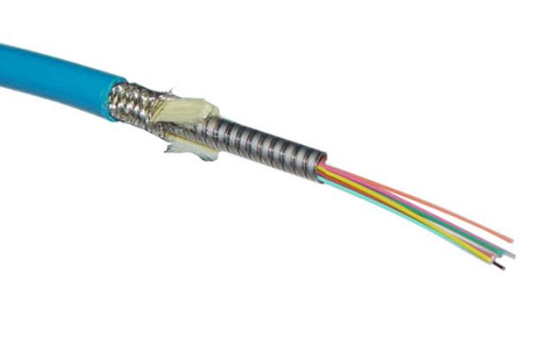Oct. 28, 2023
Armored fiber optic cable is a specialized type of optical cable designed to provide enhanced protection and durability for the fragile glass fibers that transmit data through light signals. This type of cable is commonly used in situations where standard fiber optic cables might be susceptible to damage from external factors such as physical stress, environmental conditions, or rodent interference. In this article, we will explore the various aspects of armored fiber optic cable, including its construction, applications, benefits, and some of the key considerations when choosing this cable for specific purposes.
Construction of Armored Fiber Optic Cable:
Armored fiber optic cable, as the name suggests, features an additional layer of protective armor around the inner core of optical fibers. The primary components of armored fiber optic cable include:
1. Optical Fiber Core: This is the central part of the cable, consisting of multiple individual glass fibers that carry data in the form of light pulses. These fibers are extremely thin and fragile, which is why they require protection.
2. Buffer Coating: The optical fibers are usually surrounded by a buffer coating, typically made of a soft and flexible material like acrylate. This coating helps protect the fibers from physical stress and allows for easier handling during installation.
3. Strength Member: The strength member is a layer of material that adds structural reinforcement to the cable. It can be made of materials like Kevlar, fiberglass, or aramid yarn, which provide tensile strength to the cable and protect it from stretching or bending too much.
4. Armor Layer: The armor layer is the distinctive feature of armored fiber optic cable. It serves as a robust shield to protect the cable from external threats. The armor can be constructed from various materials, such as corrugated steel, aluminum, or even a combination of materials.
5. Outer Jacket: The outer jacket is an additional layer of protection that covers the armor and other cable components. It helps shield the cable from environmental factors like moisture, chemicals, and UV radiation.

Multi-fibers Armored Optical Fiber Cable
Applications of Armored Fiber Optic Cable:
Armored fiber optic cables find applications in a wide range of industries and environments where standard fiber optic cables would be insufficient. Some common applications include:
1. Outdoor Installations: Armored cables are ideal for outdoor installations where they are exposed to harsh weather conditions, moisture, and physical damage. They are commonly used in telecommunications, surveillance systems, and industrial networks.
2. Underground Deployments: When fiber optic cables are buried underground, they are susceptible to damage from rocks, roots, and other objects. Armored cables offer the necessary protection in these scenarios.
3. Industrial Environments: In industrial settings, such as factories and manufacturing facilities, there is a higher risk of cables being exposed to chemicals, oils, and physical wear and tear. Armored cables are designed to withstand these challenges.
4. Rodent-Prone Areas: Rodents like rats and squirrels can chew through standard fiber optic cables, causing extensive damage. The armored layer acts as a barrier against rodent interference.
5. Aerial Installations: When cables are suspended above ground on poles or along building facades, they are vulnerable to environmental conditions and potential physical damage. Armored fiber optic cables offer protection in such aerial installations.
6. Military and Defense: The military often requires secure and rugged communication networks in challenging environments. Armored fiber optic cables are used for tactical communications and military applications.
Benefits of Armored Fiber Optic Cable:
1. Enhanced Durability: The armor layer provides substantial protection against physical damage, making armored cables more durable than their non-armored counterparts.
2. Environmental Resistance: The outer jacket and armor shield the cable from moisture, chemicals, and UV radiation, ensuring reliable performance in a variety of environmental conditions.
3. Rodent and Pest Resistance: Armored cables are effective at deterring rodents and pests that might chew through unprotected cables, reducing the need for frequent repairs.
4. Longevity: Armored cables have a longer service life due to their robust construction, resulting in cost savings over time.
5. Reliability: The added protection of armored cables translates to greater network reliability, making them suitable for critical applications where downtime is not an option.
6. Ease of Installation: Despite their added protection, armored fiber optic cables are not significantly more difficult to install than non-armored cables, making them a practical choice for many applications.
Considerations When Choosing Armored Fiber Optic Cable:
1. Type of Armor: There are different types of armor available, including corrugated steel, aluminum, and interlocking armor. The choice of armor depends on the specific environmental and mechanical requirements of the installation.
2. Fiber Count: Armored cables come in various configurations, from single fibers to multiple fiber counts. Choose a cable that meets the data transmission needs of your application.
3. Armored vs. Non-Armored: Assess whether armored fiber optic cable is necessary for your installation. In some cases, standard non-armored cables may suffice, which can be more cost-effective.
4. Compatibility: Ensure that connectors and equipment used in your network are compatible with armored cable. Special connectors may be required to terminate the cable ends.
5. Installation Environment: Consider the specific challenges of your installation environment, including exposure to chemicals, temperature extremes, and physical stress, when selecting an armored cable.
6. Budget: While armored cables offer significant advantages, they can be more expensive than non-armored alternatives. Evaluate your budget and the long-term cost benefits when making a decision.
conclusion
In conclusion, armored fiber optic cable is a robust and durable solution for various applications where standard fiber optic cables may be inadequate. Its construction, which includes a protective armor layer, makes it suitable for challenging environments, including outdoor, underground, industrial, and military settings. The added protection enhances cable longevity, reliability, and resistance to physical and environmental threats. When choosing armored fiber optic cable, it's essential to consider factors such as the type of armor, fiber count, installation environment, and budget to ensure the cable meets your specific requirements. By selecting the right armored cable for your needs, you can establish a reliable and resilient optical fiber network capable of withstanding adverse conditions.

















